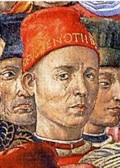
Self-portrait - detail from the Journey of the Magi (1459),
Palazzo Medici, Florence
Benozzo Gozzoli trained in Florence, where he worked with Lorenzo Ghiberti on the Porta del Paradiso (1444-7) of the Baptistery and with Fra Angelico on the frescoes (1444-45) in San Marco. He also worked with Fra Angelico on two important commissions outside Florence:
-
✴the frescoes (1447) in the chapel of Pope Nicholas V in the Vatican; and
-
✴on the frescoes (1448) on the ceiling of the Cappella Nuova of the Duomo, Orvieto (see below).
The most important commission of his life came in 1459, when the Medici summoned him to Florence to execute frescoes (1459-60) of the Journey of the Magi on the walls of the chapel in their palace.
Assisi
Christ crowned with thorns (ca. 1460)
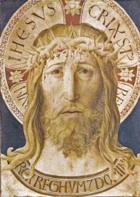
Foligno
Angel of the Annunciation (ca. 1449)
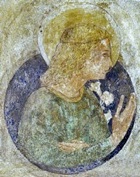
The fresco is attributed to Pierantonio Mezzastris or Benozzo Gozzoli: it is almost certainly based on the cartoon that was used for Benozzo’s fresco in Narni (see above). It has to be said, however, that there is no documentary evidence that Benozzo was ever in Foligno.
Montefalco
Work at San Fortunato
One of the frescoes in San Fortunato is signed by Benozzo Gozzoli and dated by inscription to 1450. A number of other works in or from the church are attributed to him.
Fr. Antonio da Montefalco, the Vicar Provincial of the Observant Franciscans of Umbria, who established the new community of Observant Franciscan friars at San Fortunato in 1446, was close to Pope Nicholas V. He must therefore have been aware of the work of Benozzo Gozzoli in the Cappella Nicolina, Rome. It thus seems likely that he invited the artist to San Fortunato.
Frescoes of the Cappella di San Fortunato (1450)

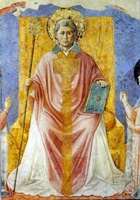
The frescoes in the chapel on the righ were largely destroyed in the 17th century when a new altar was installed. The surviving fragments comprise:
-
✴part of a Madonna and Child enthroned with a musical angel, with the inscribed signature and date at the base of the right side of the throne; and
-
✴San Fortunato enthroned, in which he carries the rod that he had used to drive his oxen, which miraculously burst into leaf when it was stuck in the ground after his death. This fragment of a larger fresco is now surrounded by a 17th century frame, with fragments of the figures of kneeling censing angels to the sides.
Frescoes above the portal (ca. 1450)

-
✴the Madonna and Child with SS Francis and Bernardino of Siena and two angels in the lunette; and
-
✴seven angels above.
This image of St Bernardino was painted very shortly after his canonisation in 1450.
Sarcophagus of St Severus

Assumption of the Virgin (ca. 1450)
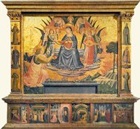
The main scene depicts the Assumption of the Virgin, in which the Virgin passes her girdle to St Thomas. Standing figures of saints decorate the sides of the frame;
-
✴SS Francis; Fortunatus and Antony of Padua to the left; and
-
✴SS Louis of Toulouse, Severus and Bernardino of Siena to the right.
The predella depicts four scenes from the life of the Virgin. (There is a copy of it on the left wall of the church).
Panels of a Diptych (ca. 1450)
These panels, which were subsequently used to decorate a cupboard in the convent, were sold in 1945. One of them, which depicts the Crucifixion with saints, was re-discovered in 1960 in a private collection in Paris and attributed to Benozzo Gozzoli. The subject and present location of the matching panel is unknown. It seems probably that Fra. Antonio da Montefalco commissioned the diptych originally for his private devotions.
Work at San Francesco
Fra Jacopo da Montefalco, , who was the Guardian of the convent of San Francesco (now the Pinacoteca) and a close associate of Fra Antonio da Montefalco, commissioned Benozzo Gozzoli to execute a number of works for this church. It belonged to the Conventual Franciscans and had been restored in 1448.
Frescoes in the presbytery (1452)
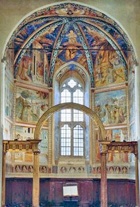
-
✴the commissioner of these frescoes, Fra Jacopo da Montefalco, on the left; and
-
✴the name of the artist and the date, on the right.
The frescoes depict:
-
✴twelve scenes from the life of St Francis, which are individually illustrated in the Web Gallery of Art, on the walls and in the lunettes above;
-
✴St Francis in Glory with SS Louis of Toulouse, Rose of Viterbo, Catherine of Siena and Antony of Padua, in the vaults;
-
✴SS Clare of Montefalco, Elzear (a Franciscan tertiary who died in 1323 and was canonised in 1369) , Fortunatus, Agnes of Assisi, Louis and Severus surround the window;
-
✴St Francis displaying the stigmata, adored by twelve of his early followers, in the tondi under the entrance arch; and
-
✴23 “preservers of the faith” in tondi in the lowest order, above the choir stalls.
Fr Jacopo almost certainly decided the iconography of the scenes from the life of St Francis, which are chosen to identify him as “alter Christus” (the other Christ) and identified by inscriptions. He is depicted in two scenes: St Francis preaching to the birds; and St Francis blessing Montefalco.
The cycle is designed to be read from the bottom, although the scenes are not arranged in strictly chronological order. The angel who stigmatised St Francis is depicted above the window, at the centre of the composition, while St Francis kneels among the rocks of La Verna in the lunette to the right. [A scene of the conversion of St Francis was lost when the window was enlarged, but its inscription survives.]
Frescoes in the Cappella di San Girolamo (1452)
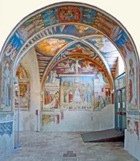
These works include:
-
✴a frescoed polyptych of the Madonna and Child with SS Antony of Padua and Jerome on the left and SS John the Baptist and Louis of Toulouse on the right, which is signed and dated on the fictive frame;
-
✴a Crucifixion with SS Dominic and St Francis on the left and SS Romuald Sylvester on the right and angels collecting the blood of Christ (above);
-
✴scenes from the life of St Jerome, which flank the fictive polyptych and extend across the right wall;
-
✴the Evangelists (in the vaults);
-
✴Christ blessing with angels, under the entrance arch;
-
✴SS Sebastian and Bernardino of Siena, on the right entrance pilaster; and
-
✴St Catherine of Alexandria, on the left entrance pilaster.
St Clare of Montefalco (1452)
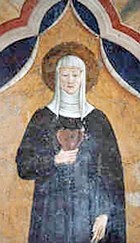
Narni
Annunciation (ca. 1449)

The figure of the angel seems to have been inspired the the angel in the Annunciation (1438-45) by Fra Angelico in the corridor of the Convento di San Marco, Florence. Stylistic considerations suggest that it pre-dates Benozzo’s work at Montefalco (see below).
The panel, which is now in the Pinacoteca, has been restored on a number of occasions, most recently in 2002.
Orvieto
Works for the Duomo
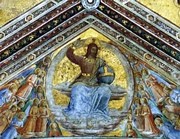
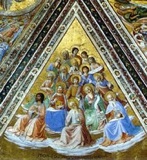
Christ in Judgment Prophets
Benozzo Gozzoli worked under Fra Angelico on the first phase of the decoration of the Cappella Nuova of the Duomo in 1447. Both artists arrived in Orvieto in June, together with two apprentices, and the Opera del Duomo put the local painter Pietro di Nicola Baroni at his disposal. They frescoed two of the four sections of the vault nearest the altar, which depicted:
-
✴Christ in Judgment; and
-
✴the Prophets.
Fra Angelico left Orvieto for Rome in September 1447, as allowed for in his three-year contract. However, the demand for his services from Pope Nicholas V meant that he never returned, albeit that some minor work was subsequently carried out by his assistants.
Benozzo Gozzoli is documented with Fra Angelico in Rome in 1448, but he was back in Orvieto by December:
-
✴A cartoon that Benozzo made for a stained glass window for the Opera del Duomo at that time was documented, although neither the drawing nor the window survive.
-
✴Benozzo began an Annunciation for a lady called Gianna Gregori in 1449, but she subsequently changed her mind. He therefore replaced her coat of arms with that of the Opera del Duomo and donated it to them to cover debts that he had incurred. This work, which no longer survives, was probably based on the Annunciation that does survive at Narni (see above).
Benozzo offered to take over the role of Fra Angelico in July 1449, but this offer seems to have been declined. Work probably stopped completely in December 1449, and Benozzo Gozzoli began work in Montefalco in 1450 (see above).
Perugia
Sapienza Nuova Altarpiece (1456)
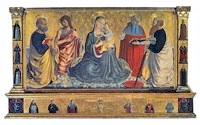
This altarpiece, which is signed and dated, was commissioned for the altar of the Cappella di San Girolamo of the Sapienza Nuova. It has the same structure as the earlier altarpiece (ca. 1450) that Benozzo Gozzoli painted for San Fortunato, Montefalco, which is now in the Pinacoteca Vaticana, Rome (see above). The college gave it to the Academia di Belle Arti, Perugia in 1816 and it is now in the Galleria Nazionale, Perugia.
The main panel depicts the Madonna and Child seated on the ground in a meadow (an iconography known as the Madonna of Humility) against a gold background with SS Peter, John the Baptist, Jerome (to whom the chapel was dedicated), and Paul.
The predella depicts:
-
✴a central group of the Man of Sorrows with flanking half-length figures of the Virgin and St John the Evangelist;
-
✴half-length figures of SS Thomas Aquinas and Laurence to the left and SS Sebastian and Bernardino of Siena to the right; and
-
✴the Guidalotti arms at the extremes.
The other saints depicted on the sides of the frame are:
-
✴SS Dominic, Francis and Peter Martyr on the left; and
-
✴SS Catherine of Alexandria, Elizabeth of Hungary and Lucy on the right.
Elisabetta Guidalotti, whose brother Bishop Benedetto Guidalotti had founded the college, is documented as having made substantial donations to the chapel after her brother’s death and was named in the statutes of the college as the only woman allowed to visit it. The presence of the Guidalotti arms on the predella and of St Elizabeth among the depicted saints suggests that she commissioned the altarpiece.
Terni
Mystic marriage of St Catherine (1466)
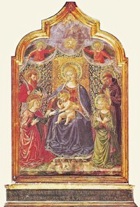
This image was highly venerated and normally kept behind a screen, but it was displayed for a short period each year for worship. It was kept in a side chapel until 1680, when Ludovico Rustici arranged for it to be translated to a new wooden structure that he had commissioned in the newly rebuilt presbytery of the church.
The image passed to the Commune when the Poor Clares, who had moved to Santa Maria dell’ Oro in 1862, left in 1895. A dispute with the Rustici family over its ownership was resolved in favour of the Commune in 1899. Documentation at the time of the litigation reveals that the panel was part of a triptych. However, the side panels are no longer known and there is no other surviving record of them.
Vienna
Madonna of Humility with saints (ca. 1452)
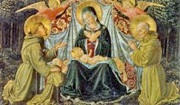
This undocumented panel in Kunsthistorisches Museum, Vienna, which depicts the Madonna and Child seated in a meadow with SS Francis and Bernardino of Siena, is attributed to Benozzo Gozzoli on stylistic grounds. The Franciscan donor portrayed in the panel is almost certainly Fra Jacopo da Montefalco, who was also portrayed in the frescoes that he commissioned from Benozzo Gozzoli for the apse of San Francesco, Montefalco. It seems Fra Jacopo commissioned the panel while Benozzo was working on the frescoes there.












